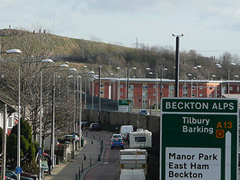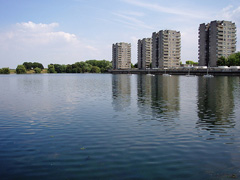


Luxury apartments, skyscrapers, investment bankers… these are some of the things easily associated with the Docklands. But there is a whole other world beyond Canary Wharf, one that’s rather less glossy than its wealthy neighbour.
Canning Town
According to a 2011 study by the End Child Poverty campaign, 55% of children living in Canning Town are below the poverty line. It’s been a problem since Victorian times, when the casual nature of employment on the docks meant that workers struggled to make a living all year round. Affording decent housing was out of the question, so unscrupulous developers built homes that were cheap and unhygienic which often lacked basic facilities like a toilet. It was common for more than one family to be crammed into a small home, and diseases like small pox and cholera spread quickly.
It didn’t help that there were numerous companies making noxious chemicals based here. By law these industries couldn’t be located within the metropolitan area of London, and Canning Town was just over the border.
There have been plenty of catastrophes over the years too. In 1917 a company that manufactured TNT exploded, killing 73 people. Factories and homes were badly hit during World War II, with many casualties and many more who were made homeless (it is estimated that around 85% of homes in the Docklands area were destroyed during the Blitz). New high rises were built to replace the old slums, however disaster struck again in 1968 when a gas explosion caused a whole corner of a tower block to tumble, killing three people and instilling fear in those who lived in similar constructions.
Unemployment is still a big problem, however efforts are being made to improve things. The Jubilee line was extended in 2000, providing an easy link between Canning Town and the West End, and once the Crossrail is completed it will connect to Heathrow Airport in 45 minutes. It is also hoped the recent transformation of neighbouring Stratford will bring new commerce and job opportunities to the area. \n\nBeckton
At the very end of the Docklands Light Railway lies Beckton, home to vast areas of brownfield land once inhabited by warehouses. Plans to build a dock here in the 19th century never materialised and Beckton didn’t receive the same influx of industry and urbanisation as other parts of the Docklands.
It did become known for Beckton Gas Works (in fact the area is named after company owner Simon Adams Beck) and sewage, as Beckton was fortunate enough to be where all of North London’s waste ended up. On the plus side, it was this drainage system that put a stop to outbreaks of cholera in the capital.
When the factories closed down and employment levels dropped, residents moved away. In the 1980s there was a push for new homes, shops, schools and leisure centres to be built, and Beckton became something of a success story. The addition of the DLR has made it easy to access the city, but for all the money that’s been poured into the area over the last few decades there is still something eerie about the kilometres of empty wasteland around it. \n\nThamesmead
Over the river from Beckton is Thamesmead, an area that has become notorious in the media for gang-related violence. Thamesmead was developed in the 1960s with the aim of providing housing to East London inhabitants who’d been living in overcrowded properties, or who had been displaced due to bombing during the war. The vision was practically utopian: futuristic architecture, homes that were located close to nature reserves and plenty of green spaces would make this a highly desirable neighbourhood. In fact when Thamesmead was first unveiled prospective tenants were assessed on whether they were suitable to move in. Today it’s regarded as one of the roughest parts of London, a reputation that doesn’t exactly help its efforts to improve its image.
So what went wrong? It seems that the project was doomed from the start. As much of Thamesmead was built on marshland there was a very real risk of flooding, and to prevent this homes could not be built on the ground floor. The raised walkways and flats were seen as avant-garde at the time, even winning awards for design, but the downside was that this left big empty spaces beneath the buildings with no surveillance, which led to vandalism and petty crime.
Plans to build a shopping centre and train station were thwarted due to lack of funds, leaving Thamesmead without any retail opportunities, entertainment or decent transport links. With nothing to do and no local jobs, anti-social behaviour became an issue. Rather than fulfil its initial aim of housing people from a mixture of backgrounds and ages it became where “problem families” from other boroughs were re-housed. As early as the 1970s, those who could afford to move out did. Thamesmead became symbolic with deprivation, with Stanley Kubrick filming one of the violent scenes of A Clockwork Orange here.
But although it didn’t live up to its initial promise, there are high hopes for Thamesmead. The Trust recently secured more than £11m of investment for the area, some of which has been spent on a community centre built out of disused arches, and Sporting Club Thamesmead, with facilities for football, netball, basketball, cricket, golf and tennis. There are also numerous community groups, offering dance classes, gymnastics, arts and crafts, and motor mechanics, as well as bingo clubs, over-50s groups and faith groups.
With property prices across the capital continuing to reach dizzying heights, perhaps in years to come SE28 will become another of London’s gentrified communities?


